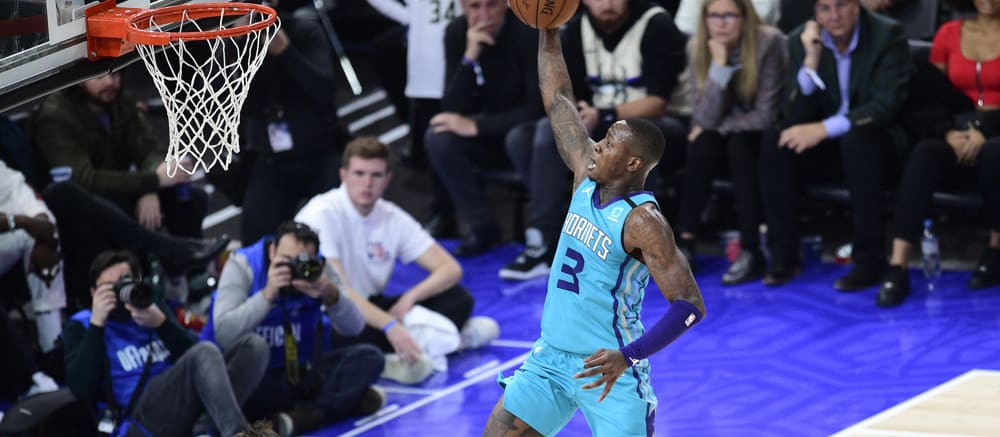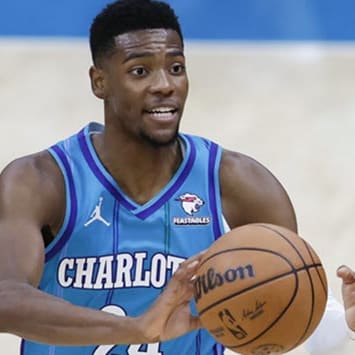This article is part of our NBA Draft Kit series.
With the NBA Draft and (most of) free agency behind us, the NBA season is now closer than ever. Just over three weeks remain until opening night, but the league announced Friday that the preseason will begin Dec. 11.
While the preseason will only run for eight days -- and likely feature extensive rest for veterans and star players -- it will be our first opportunity to truly evaluate the revamped rosters around the league. Some teams' depth charts are fairly straightforward, but others are much more complicated and may not be settled until after exhibition play.
With that in mind, here are five teams and situations to monitor once play begins.
 Atlanta Hawks
Atlanta Hawks
In terms of moving from bad team to playoff contender, no franchise stepped on the accelerator harder than the Hawks this offseason. Atlanta already had a decent young core in place in Trae Young, John Collins, Clint Capela, Kevin Huerter, Cam Reddish and De'Andre Hunter, but that didn't stop the Hawks from aggressively pursuing a number of veteran free agents.
With Rajon Rondo, Danilo Gallinari, Bogdan Bogdanovic, Kris Dunn and Tony Snell now in place -- not to mention No. 6 overall pick Onyeka Okongwu -- Atlanta is suddenly one of the deepest teams in the entire league. There's no question the talent is there to make a run at seventh, eighth, or maybe even sixth seed in the East, but from a fantasy perspective, the Hawks will be difficult to evaluate.
Young and Collins should remain borderline-elite fantasy players, while the jury is still (somewhat) out on Capela, who's yet to suit up for the Hawks after coming over at the deadline last season. At the very least, Capela should remain a points/rebounds/blocks/field goal percentage contributor, though perhaps at a lower volume compared to his last few healthy years in Houston.
Coming over from Sacramento, Bogdanovic is undoubtedly in a better basketball situation, but it's difficult to envision a path to a larger role than the one he held last season. Bogdanovic can play three positions, but he'll start alongside one of the highest-usage players in the league, while also sharing possessions with Collins and Gallinari.
In terms of year-over-year value, Gallinari figures to take a notable hit after functioning as the second or third scoring option in Oklahoma City. He'll still get his touches, but Gallinari may be better off helping lead the bench unit, as opposed to fighting for shots if the Hawks opt to roll out a Young-Bogdanovic-Gallinari-Collins-Capela starting five.
Perhaps the biggest losers for fantasy are Huerter and Reddish. Huerter battled injuries for most of last season, but he had already emerged as one of the better young catch-and-shoot threats in the league. Meanwhile, Reddish got off to a dreadful start last season, but the No. 10 pick in the 2019 draft was in the midst of an impressive stretch when the season was suspended in mid-March.
Over his final 21 games, Reddish averaged 14.6 points, 3.9 rebounds, 1.1 steals and 0.5 blocks with a 47/42/83 shooting line. The Duke product should remain an important bench piece, but it's difficult to envision him earning enough opportunity to be relevant in standard leagues -- at least to begin the season.
 Brooklyn Nets
Brooklyn Nets
The Nets have some sorting out to do as far as how Caris LeVert, Spencer Dinwiddie, and new addition Landry Shamet will fit into the rotation, but the pecking order is pretty clear: The team belongs to Kevin Durant and Kyrie Irving, and everyone else will be fighting for scraps.
Things aren't as clear at center, where the Nets once again find themselves choosing between Jarrett Allen and DeAndre Jordan. At this point in their careers, Allen is the more effective player. But Jordan is Durant and Irving's guy, and it's no coincidence he immediately moved into the starting lineup after Kenny Atkinson was fired last season. Ultimately, which player earns the starting designation is less important than which of the two gains the minutes advantage.
Fantasy-wise, the ideal situation might be Jordan serving as the nominal starter at 15-20 minutes, while Allen plays 25-30 minutes off the bench. Last season, the split was a bit more even (22.0 for Jordan, compared to 26.5 for Allen), though Jordan did not join the team in the Orlando bubble, where Allen played 34.1 minutes per game and had a couple of head-turning performances. It'll be a delicate balance for rookie head coach Steve Nash, who could be torn between appeasing his superstars and playing his best lineup.
 Charlotte Hornets
Charlotte Hornets
On paper, James Wiseman would have been the perfect fit for the center-deprived Hornets, but when the Memphis standout went to Golden State at No. 2, Charlotte responded by taking the best player available. Adding LaMelo Ball to a roster already featuring Terry Rozier and DeVonte' Graham creates an interesting dilemma in the backcourt.
Neither Rozier nor Graham is a true star, let alone a superstar, but each is coming off of the best season of their respective careers. Graham was one of the league's biggest surprises in 2019-20, while Rozier shot better than 40 percent from three, finally proving capable of playing a more efficient style. Ball enters with a much higher pedigree than Rozier and Graham, but he'll have to earn a starting spot on a team with playoff ambitions after adding Gordon Hayward in free agency.
To begin the year, the most likely scenario is Charlotte easing Ball into the league in a bench role behind Graham. At 6-7, Ball has the size to defend wings and rebound against bigger players, but at this stage he's a true point guard on the offensive end. Both Graham and Rozier can play off the ball, but it remains to be seen whether the Hornets would be willing to play all three together.
The good news for Ball's fantasy value is he won't have much competition from other reserves. There's no question Charlotte improved this offseason, but the bench remains incredibly thin. Other than Malik Monk -- who's already on thin ice -- Ball should have a clear path to a sizable workload in Year 1. Assuming the minutes are there, Ball could be a strong assists and rebounds (for a guard) contributor right away. The question will be whether he can shoot the ball well enough to avoid being a significant drag in the percentage categories.
 Minnesota Timberwolves
Minnesota Timberwolves
Like the Hornets, the Timberwolves took the best player available on their board, rather than reaching for a bigger need in the frontcourt. Anthony Edwards is an easier fit at the 2 or the 3 than Ball, but in Minnesota he'll face even more competition for minutes.
The moment Edwards was drafted, it looked as though he could be penciled in next to D'Angelo Russell in the backcourt. An hour later, the Timberwolves acquired Ricky Rubio from the Thunder. Then, a few days later, they re-signed Malik Beasley to a four-year, $60 million contract. On the whole, Minnesota is deeper and more talented than last season, but the decisions to add Rubio and retaining Beasley both work against Edwards' fantasy value.
It's possible he could start over Beasley at the three, but at this stage that's relatively unlikely. Edwards isn't as polished as most No. 1 picks, and the Wolves are one of several teams expecting to battle for one of the final playoff spots in the West. Certainly, Edwards will have plenty of chances to prove himself in Year 1, but he won't be handed the 30-minutes-per-night role many top picks walk into.
 Oklahoma City Thunder
Oklahoma City Thunder
No team has been more active than the Thunder over the last two weeks. With a treasure trove of future picks, cap space, more future picks, and no pressure to win anytime soon, Sam Presti has the luxury of operating his team like an NBA 2K franchise. Five of the Thunder's top six scorers from last season are no longer around, leaving Shai Gilgeous-Alexander as the lone holdover and now clear No. 1 option -- both in real life and in fantasy.
It's been a strange start to the career of Gilgeous-Alexander, the No. 11 overall pick in 2018. After starting 73 games as a rookie for the Clippers, he was sent to Oklahoma City in the Chris Paul trade last summer. Starting alongside perhaps the best floor general in the league, Gilegous-Alexander took on more of a score-first role as a sophomore. This season, he'll likely be asked to return to more of a hybrid scorer-distributor role, and he could be positioned for a breakout fantasy campaign.
Beyond Gilgeous-Alexander is where things get interesting. The Thunder will probably be among the league's worst teams next season, but that doesn't mean they'll be irrelevant from a fantasy perspective. Last season, the average NBA team produced roughly 111 points, 45 rebounds, 24 assists, eight steals and five blocks per game. OKC's depth chart is a mess, but -- bottom-feeder or not -- that production has to come from somewhere.
At center, Al Horford will be a bounceback candidate after a forgettable one-year detour in Philadelphia. He's not exactly the high-upside young player most rebuilding teams target, but the Thunder don't have much in terms of appealing depth (Mike Muscala, Vincent Poirier, Omer Yurtseven) behind Horford.
If you're looking for a late-round lottery ticket, targeting one of the Thunder's plethora of young wings make sense. How the rotation shakes out will be something to monitor during the preseason, as Hamidou Diallo, Lu Dort, Frank Jackson, Justin Jackson, Darius Bazley, and Admiral Schofield could all compete for rotation spots. Granted, no one in that group is super-appealing, but as your draft nears its close, just keep repeating to yourself: someone has to score, someone has to score, someone has to score.












